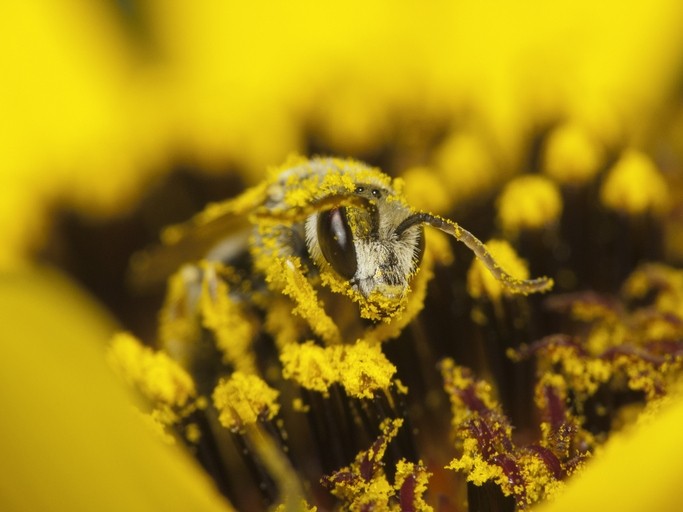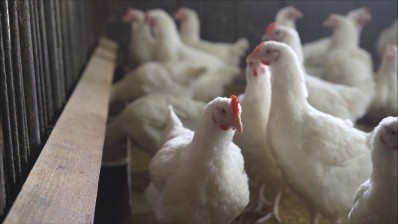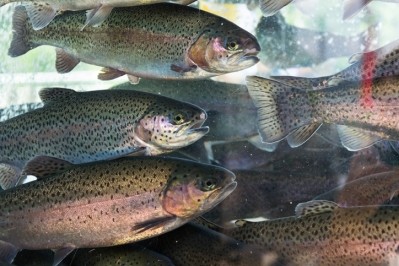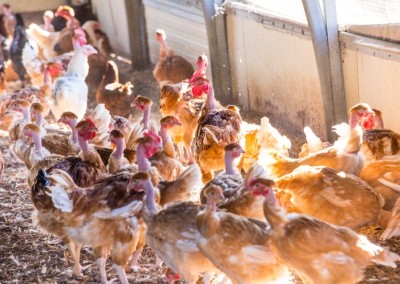Special Edition: Aqua feed innovation
Bee pollen carotenoids may support trout growth, improve color

Researchers from the department of animal production at the National University of Columbia and the Institute of Food Science and Technology at the National University of Columbia explored the use of a bee pollen extract in the diets of farmed rainbow trout.
The study was published in the journal, Aquaculture.
“The aim of this study was to compare the effects of carotenoids from bee pollen extracted in vegetable oil with synthetic carotenoids (astaxanthin) on the productive parameters and meat pigmentation of rainbow trout,” the researchers said.
The researchers compared the use of diets with no carotenoid (C-), a synthetic carotenoid (C+) and diets with two levels of bee-pollen generated carotenoid (P1 and P2) with rainbow trout and found that there were few differences in terms of fish growth. However, the diet with 50 mg kg-1 bee pollen (P2) did influence fish growth at some stages.
Trout receiving the diet with the commercial additive had the highest “pigmentation intensities".
“The results obtained in the evaluation of the color and the TCC in fillets indicated that rainbow trout fed with carotenoids extracted in vegetable oil from bee pollen (PVO) had a pale pink color compared to a diet without added carotenoids,” the researchers said. “Therefore, testing a new high level of carotenoids in PVO is recommended.”
Green practices, feed ingredients
Consumers buying farmed salmonids products can be influenced by the red or pink color of the fish skin and flesh, the researchers said. Keeping the “natural skin pigmentation” of fish alters market price.
One challenge for producers of rainbow trout is the fish’s lack of ability to “synthesize the carotenoids responsible for salmonid pigmentation, such as astaxanthin (3,3′-dihydroxy-β,β-carotene-4,4′-dione) and canthaxanthin (β,β-carotene-4,4′-dione),” they said. To address the issue, producers feed synthetic carotenoids in the final feeding stage.
However, while synthetic carotenoids are available, their cost and low retention rate has been a concern for producers. Consider interest in healthier foods has stimulated a switch from synthetic colorants to natural ones.
“During the aquaculture of rainbow trout, the use of plant carotenoids in feeds has also demonstrated biological effects and nutritional functions essential for fish health, such as mitigation of the effects of drug administration, protection against oxidative stress, and resistance against inoculated diseases, which reduce the cost of required medicines,” the researchers said. “A study using diets containing β-carotene from sweet potato and gut weed indicated that natural β-carotene can enhance the color of fish and that there is a need to develop a technique to enhance proper coloration of the fish using inexpensive natural products.”
Why include bee pollen in trout feed?
Another way to include plant-based carotenoids in aquafeed involves using vegetable oil to extract the colorant, the researchers said. Those carotenoid-rich oils can then be added to feeds using a coating process.
The practice is considered “green” because it trims the use of “toxic solvents” and does not requires further separation or processing, which reduces the amount of energy used, they said.
“Coating the feed pellets with an oil phase after granulation is a strategy that increases the content of additives, calories, absorption of fat-soluble vitamins, and essential fatty acids in animal feed,” they said. “This simple approach might reduce the cost and enhance the feasibility of using natural carotenoids for salmonid nutrition.”
Bee pollen is a possible sustainable carotenoid source for use in aquafeeds, the researchers said. Recent research found that the substances have a carotenoid content that ranges from 170 to 2,100 β–carotene equivalent kg−1, which would allow it to be used as a carotenoid ingredient in feed.
However, the use of bee pollen in feed is a newer practice, they said.
Previous research evaluated the use of a bee pollen extract in trout production and found that adding a pollen extract to water reduced amounts of malondialdehyde while raising total antioxidant levels in the fish, they said. But, little information is available regarding the influence of in-feed carotenoids generated from bee pollen on fish growth and muscle pigmentation.
Feeding trial details
In the feeding trial, 144 rainbow trout received one of four diets for an 8-week period.
The diets included the commercial feed without pigment (C-), the feed with supplemental synthetic carotenoid at 50 mg kg-1 (C+), the feed with bee pollen-extracted carotenoid at 25mg of total carotenoids per kg (P1) or with bee pollen-extracted carotenoid at 50mg (P2), the researchers said.
A commercial trout feed along with commercially available soy lectin, synthetic astaxanthin and dry bee pollen were used to make the diets, they said. Vegetable oil was used to extract the bee pollen-based carotenoid or pigmented vegetable oil (PVO) from the dried bee pollen.
Total carotenoid content (TCC) in the diets was determined, they said. Adding, “The final results of the TCC analysis method were presented as mg of β-carotene per 100 g of oil.”
“The TCC in PVO obtained from a 0.25:1 ratio (bee pollen to vegetable oil) was 278.72 ± 7.81 mg of β-carotene equivalent per 100 g oil,” they said. “This value was taken into account when preparing the experimental diets.”
Feed intake was noted daily, growth parameters were recorded at the start and end of the feed trial and on days 14, 28 and 42, the researchers said. A sample of fish was collected every 14 days to check weight, growth, weight gain, length gain, condition and specific growth rate.
Fish were harvested on the final day of the feeding trial and the liver and viscera were examined to establish hepatosomatic index (HSI) and viscerasomatic index (VSI), they said. Fish also were analyzed for color to determine CIE-LAB parameters and the SalmoFan colorimetric range – ranging from pale red at 20 to 34 (dark red).
Fish tissue was checked for TCC, they said. “The TCC in the fillets was calculated in milligrams of equivalent β-carotene per kilogram of fillet,” they added.
Results
Throughout the feeding trial fish consumed the conventional and trial feeds at similar levels, the researchers said. No disease or mortality was recorded and growth parameters at the end of the trial were similar for fish on all diets.
During the trial, fish on the P2 diet had an increased growth spurt from day 42 to 56 and improved weight gain during the first 14 days and on days 28 to 42 compared to fish on the other diets, they said. At the end of the trial, fish on the P2 diet tended to be heavier than those on other diets.
“The P2 treatment (highest proportion of carotenoids from bee pollen) showed slight increases in weight gain, body length, and specific growth rate in periodical measurements,” they said. “Enhanced growth performance in partial sampling in the current study could be attributed to some intermediary metabolism due to carotenoids from a natural source, such as bee pollen, in the diet.”
No differences were noted for hepatosomatic index, the researchers said. But the lowest vicerasomatic index was recorded for fish on the P1 diet and the highest for fish on the C+ diet.
Fish on the negative control diet had the highest brightness, but fish on the commercial carotenoid had the darkest color, the researchers said. Fish on the trial diets were scored between the positive and negative control for all color parameters.
“Fillets of trout fed with treatments P1 or P2 had a higher carotenoid concentration and a paler pink color than those fed with a diet that did not have added carotenoids (C−),” they said.
An analysis of fish tissue found higher carotenoid levels in fish on the P1 and P2 diets than in fish on the negative control, they said.
Source: Aquaculture
Title: Effect of bee pollen extract as a source of natural carotenoids on the growth performance and pigmentation of rainbow trout (Oncorhynchus mykiss)
Authors: E. G. T. Sánchez, C. A. Fuenmayor, S. M. V. Mejía, C. Díaz-Moreno, H. S. Mahecha
DOI: available online before print: doi.org/10.1016/j.aquaculture.2019.734490















